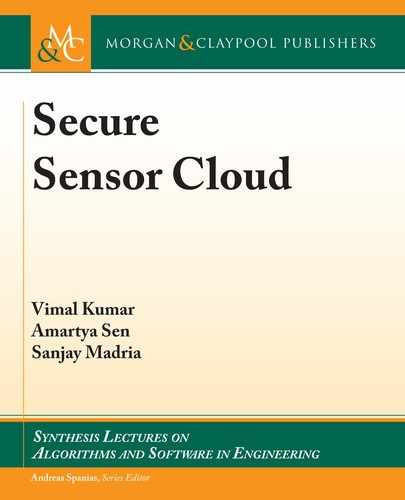
1.2. SENSOR CLOUD 5
Middleware
CO
CO
CO
CO
CO
CO
CO
CO
CO
CO
Users
WSNs
Figure 1.2: A birds-eye view of a sensor cloud.
collection. WSN owners register their network with the sensor cloud through this layer. e reg-
istration process creates a catalog of the data provided by the WSN and the associated QoS con-
straints and results in a contract between the sensor cloud and the WSN owner. After this, the
owners are responsible for maintaining the network and providing data and the sensor network
platform to sensor cloud according to the contract. e next layer in the stack is the middleware,
which connects the data collected from the sensor-centric layer to the users at the client-centric
layer. e middleware layer performs a number of important functions such as provisioning sen-
sors to user requests, managing and overseeing sensor and data usage for billing and managing
the sensor life-cycle. e top layer is the one where users interact with the sensor cloud referred
as the user-centric layer. is layer provides an interface to the user and handles session and
membership. is layer also uses the information provided by WSN owners to provide service
catalogs to the users and customizing the service-layer agreements (SLAs).
1.2.2 VIRTUAL SENSORS
Like any cloud platform, the key idea behind sensor cloud is the virtualization of resources. e
resources in a sensor cloud being the wireless sensory devices; energy, bandwidth, computing
etc. Virtualized wireless sensors are generally known as virtual sensors as opposed to the physical

6 1. INTRODUCTION
User Interface
Membership
Management
Session Management
Service Catalogs
and SLAs
WSN Maintenance WSN Registration Data Collection
Sensor Provisioning
Sensor Life-cycle
Management
Sensor Data
Management
Billing
Management
CO
CO
CO
CO
CO CO
CO
CO
CO
CO
CO CO
CO
CO
CO
CO
CO CO
Cl
ient-Centric Layer
Middleware Layer
Sensor-Centric Layer
Figure 1.3: Sensor cloud layered architecture.
wireless sensors. Multiple virtual sensors can be executed on a single physical sensors. Virtual
sensors can be used to improve resource utilization in WSNs. ey can also be used to create
complex sensors by combining multiple virtual sensors and computing capability.
e following two main approaches have been used in sensor clouds for achieving virtu-
alization of wireless sensors:
• true virtualization through Virtual Machines (VMs) and
• pseudo virtualization through middleware.
True Virtualization
True virtualization systems run a thin layer of software on the mote hardware. WSN applica-
tion software is then added on top of the thin software layer. Maté [18] was the first attempt
..................Content has been hidden....................
You can't read the all page of ebook, please click here login for view all page.
